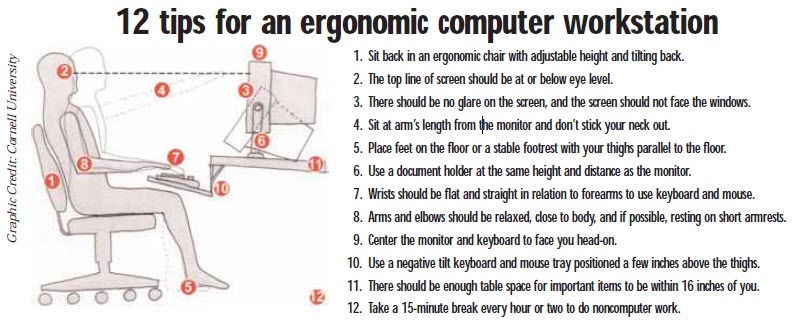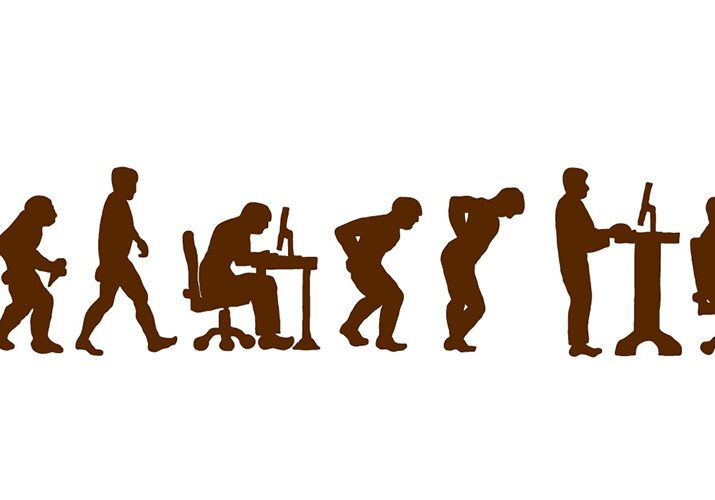Reliance on computers has resulted in secretaries, librarians, teachers, and other school staff spending more hours at the keyboard. They perform administrative tasks, do Internet searches, use e-mail, and create letters, fliers, lesson plans, and other materials. Many are running into health problems ranging from headaches, eye strain, and blurred vision, to tingling, numbness, and pain in the neck, back, shoulder, elbow, wrist, or hand.
Many students also spend part of their day peering at a computer screen and pecking at a keyboard. NJEA members can play an important role in advocating for ergonomic computer workstations for themselves and their students. The offices, libraries, and classrooms of all schools need furnishings that allow staff and students to perform computer work effectively without injury.
Develop an ergonomics program
Currently, there are no federal or state standards that require employers to provide ergonomic computer workstations. But the local association, through its health and safety committee, can establish an ergonomics program to:
- Educate members about computer ergonomics
- Educate members about computerrelated health issues
- Conduct a survey of members for computer-related problems (Note: The U.S. Department of Labor provides a computer workstation survey at its Occupational Safety and Health Administration website. Visit www.osha.gov/SLTC/etools/computerworkstations/checklist.html )
- Encourage filing of workers’ compensation claims when appropriate
- Conduct a building walk-through to evaluate and photograph computer workstations
- Meet with administration to present walk-through findings and recommendations
- Request that administration involve members in selecting computer equipment for staff and students
Report and document problems with equipment and health
Written documentation makes administrators officially aware of problems. Photographs of non-ergonomic computer workstations are compelling evidence to submit to administration along with a description of what is wrong and what would correct the problem.
Accordingly, staff must report their computer-related work injuries to administration. Otherwise it’s not a problem the administration has to deal with, and there is no documentation on file should symptoms worsen. Documenting equipment problems is also important and can help get such problems solved.
Seek workers’ compensation
Work-related carpal tunnel syndrome, rotator cuff injuries, ganglion cysts, tennis elbow, trigger finger, DeQuervain’s Disease and other computer-related repetitive strain injuries are compensable under New Jersey’s workers’ compensation system.Workers should not have to use their own health insurance, sick time, or vacation time for workrelated injuries.
Workers’ compensation benefits may include:
- Medical treatment
- Temporary compensation while unable to work
- Permanent disability for workers unable to resume any type of work
- Partial permanent disability for workers able to work but with some lasting effect from the injury or disease
The workers’ compensation system is a “no-fault” system.Workers may file claims if they believe their injuries or illnesses are job-related. Once claims are filed, employers or their insurance carriers may contest them. Final determinations are made by a judge of compensation. For more information about the Workers’ Compensation law in New Jersey, including time limitations, call the Division of Workers’ Compensation in the New Jersey Department of Labor and Workforce Development at 609-292-2515.
Do you have these computer pain risk factors?
- Long periods of computing without breaks
- Nonadjustable chair
- No support in the small of the back
- Reaching for the mouse
- Looking up or to the side at the screen
- Sticking the neck and head forward to see the screen
- Seeing reflections of windows or lights on the screen
- Wearing glasses not prescribed for computer use, especially bifocals
- Using a phone and computer at the same time
- Having tight or frequently changing deadlines
- Using a laptop computer without an external keyboard
Four Stages of Repetitive Strain Injury (RSI)
- Pre-RSI – “Funny” feeling in neck, back, shoulder, elbow, wrist, or hand
- Beginning RSI – Pain or tingling during computer work. Symptoms are relatively mild and disappear during periods of rest
- Full-Blown RSI – Symptoms occur frequently and do not disappear completely during periods of rest. Weak and clumsy movements of affected parts
- Chronic Pain – Constant pain unrelieved by rest. Sleep is disturbed by pain. Symptoms are made worse by any activity. The pain, limited movement, loss of sensation, and muscle weakness can make performing any job tasks impossible.

Internet resources for more information
- Checklist: Computer workstation health and safety – www.nycosh.org/workplace_hazards/vdt.html
- Worker survey: Where do you hurt? – www.hazards.org/detective/index.htm#
- Cumulative trauma disorders in office workers – www.state.nj.us/health/eoh/peoshweb/ctdib.htm
- A Worker’s Guide to Workers’ Compensation in New Jersey – www.nj.gov/labor/wc/forms.htm#brochures
- General information on ergonomics in schools – https://education.umn.edu/kls/ecee/teachers.html
- Guidelines on setting up computer workstations for adults – www.lni.wa.gov/IPUB/417-133-000.pdf
- Cornell University ergonomics in schools – https://ergo.human.cornell.edu/MBergo/ schoolguide.html
- Office ergonomics – www.ccohs.ca/oshanswers/ergonomics/office/
- OSHA page on computer workstations – www.osha.gov/SLTC/computerworkstation/index.html
- Computer guidelines for libraries – https://lib.ucr.edu/ergolib/
